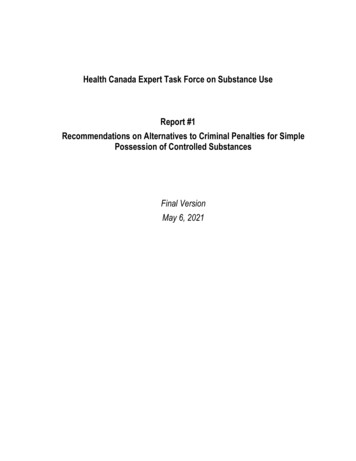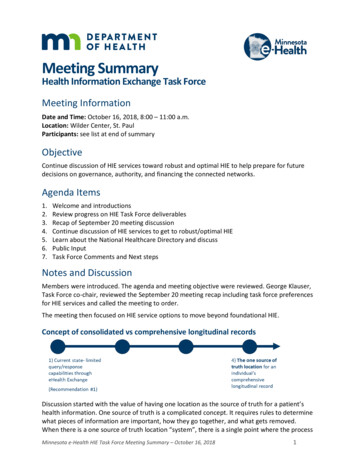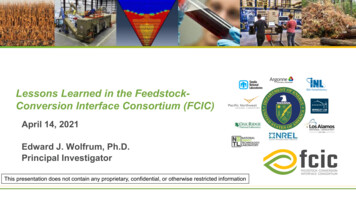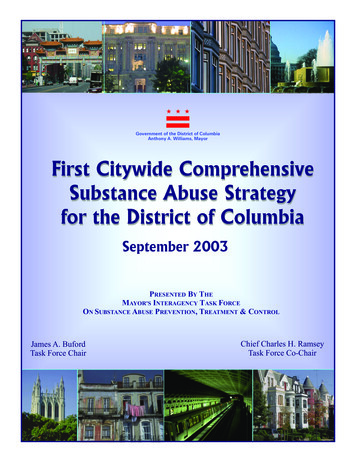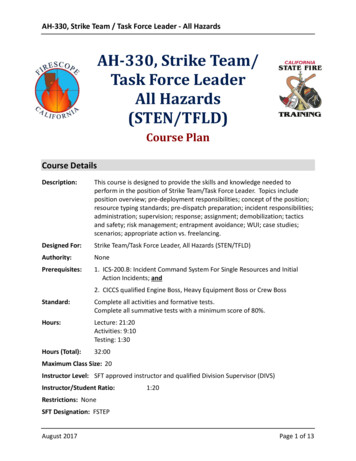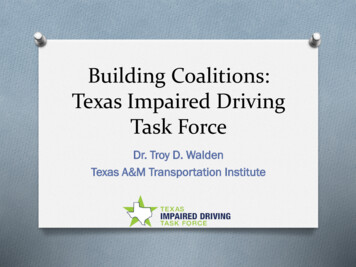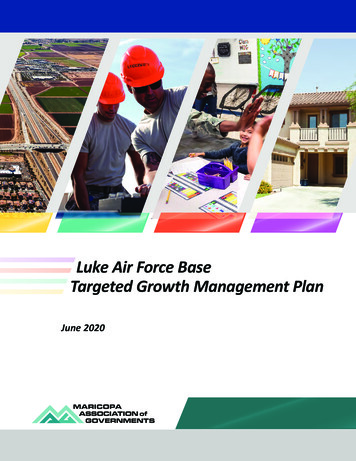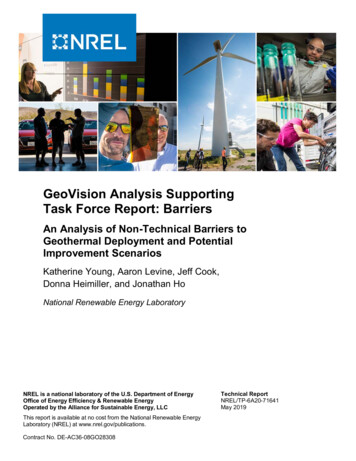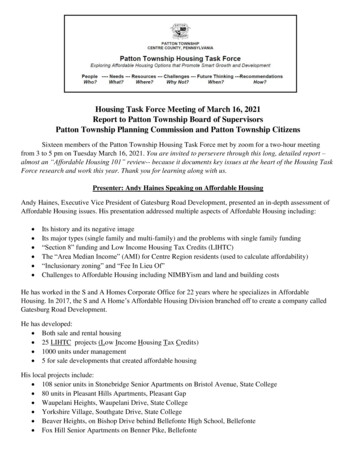
Transcription
Housing Task Force Meeting of March 16, 2021Report to Patton Township Board of SupervisorsPatton Township Planning Commission and Patton Township CitizensSixteen members of the Patton Township Housing Task Force met by zoom for a two-hour meetingfrom 3 to 5 pm on Tuesday March 16, 2021. You are invited to persevere through this long, detailed report –almost an “Affordable Housing 101” review-- because it documents key issues at the heart of the Housing TaskForce research and work this year. Thank you for learning along with us.Presenter: Andy Haines Speaking on Affordable HousingAndy Haines, Executive Vice President of Gatesburg Road Development, presented an in-depth assessment ofAffordable Housing issues. His presentation addressed multiple aspects of Affordable Housing including: Its history and its negative imageIts major types (single family and multi-family) and the problems with single family funding“Section 8” funding and Low Income Housing Tax Credits (LIHTC)The “Area Median Income” (AMI) for Centre Region residents (used to calculate affordability)“Inclusionary zoning” and “Fee In Lieu Of”Challenges to Affordable Housing including NIMBYism and land and building costsHe has worked in the S and A Homes Corporate Office for 22 years where he specializes in AffordableHousing. In 2017, the S and A Home’s Affordable Housing Division branched off to create a company calledGatesburg Road Development.He has developed: Both sale and rental housing 25 LIHTC projects (Low Income Housing Tax Credits) 1000 units under management 5 for sale developments that created affordable housingHis local projects include: 108 senior units in Stonebridge Senior Apartments on Bristol Avenue, State College 80 units in Pleasant Hills Apartments, Pleasant Gap Waupelani Heights, Waupelani Drive, State College Yorkshire Village, Southgate Drive, State College Beaver Heights, on Bishop Drive behind Bellefonte High School, Bellefonte Fox Hill Senior Apartments on Benner Pike, Bellefonte
Housing Task Force March 2021 page 2Older local examples of “affordable housing” (built prior to 1986) include: Brockerhoff House in Bellefonte—owned by Centre County Housing Authority Mount Nittany Apartments behind Hills Plaza on South Atherton Beaver Farm Apartments Spring Creek estates, Pleasant Hills Estate in Pleasant GapThe Problems of Affordable Single Family Housing Development TodayGenerally single family affordable housing needs substantial funding to offset the cost or to balance themarket.In State College, it typically costs almost 300,000 to build a house. You can sell it for over 300,000 so as ahome builder that’s a good thing-- I don’t have to use subsidy.But if I go 20 minutes outside this town or near Tyrone or between here and Altoona it still costs me probably 250,000 to build a house but I necessarily can’t sell that house in that area for 250,000 because thecomparables in that area don’t match. The bank won’t lend if the comparables (the other houses in yourneighborhood) are less than what you’re going to build it for. No one wants to be the one to build the highestcost house surrounded by lower cost houses.So there’s two problems of affordable single family housing development:One is State College where the cost is very high but the market is here. So you have a problem of how you getpeople who can’t afford a 300,000 house into a “for sale” house.Then there’s the problem of communities outside of State College and some urban areas where your housingmarket is severely under the cost of the housing.So in either of these situations there’s very limited funding available to offset the difference in the housingaffordability and the housing cost. There are some local or state programs. Some states like California orMassachusetts or Colorado have very strong single family development housing programs but Pennsylvaniadoes not.That is a struggle of how to find the funding sources to make a “for sale” housing affordable.In multi-family developments, the “Low Income Housing Tax Credit” does that (see next page.) The housingcredit basically provides us the gap between what we can afford in rentals and what it costs us to build.
Housing Task Force March 2021 page 3For Multi-Family Developments: Low Income Housing Tax Credit-- LIHTCLow Income Housing Tax Credit (LIHTC) is the largest multi-family housing financial provider. It is the mostsuccessful affordable rental production program in US history, providing 80,000 units annually.This is our main source of developing Affordable Housing right now. We typically do family projects or seniorprojects (for people over 55 or over 62). Our project in Ferguson Township-- Stonebridge Apartments—that’san 11 million project. We built 50 units. We used a combination of conventional debt and equity from LowIncome Housing Tax Credits to fund that development.For those tax credits we are required to rent to people who have less than 60 percent Area Median Income(AMI) (see next page for AMI details). Our rents for Stonebridge (which we tier range) are from 360 to 900per month for a two bedroom, well below the current market. Pennsylvania requires that units be affordable for40 years.The tax credits bring corporate investors into the affordable housing community and they come and inspect theirprojects four times a year. Pennsylvania gets about 30 million in tax credits per year. It’s a very competitiveprocess. The tax credits are allocated based on scoring criteria. Here in Pennsylvania they look at energyefficiency. Are you close to services, grocery, bus stops, schools, parks?. Does the community support it? Andwhat amenities do you give to the residents? Those amenities determine how the project is funded.The state also looks at the need and State College and Centre County are identified by the state as havinga tremendous need.
Housing Task Force March 2021 page 4HUD Area Median Income (AMI)Every housing funding source that is utilized presently by for sale and rental basically starts with the HUD*Area Median Income (AMI) This is the income level used as the “base” for calculating affordability.For Centre County, the HUD Area Median Income for a family of four is 88,700 for the entire county,It’s adjusted for family size. Every county has its own AMI. Most funding resources require 80 percent or lessof AMI. A lot of inclusionary housing projects go up to 125% of AMI.To figure out the rent take 30 percent of their gross income. Anything they are paying over that for rent isdetermined to be “housing or rent burdened.” For instance a family earning 24,000 per year (or 2,000 amonth): 30 percent of that would be 600 a month for rent. If the family is paying 1,000 a month for rent that 400 difference would be considered “rent burdened”.*HUD Department of Housing and Urban Development, established in 1965, that administers federal aid tolocal housing agencies that manage housing assistance programs.
Housing Task Force March 2021 page 5Confronting the “negative image” of Affordable HousingA negative image lingers from the history of Affordable Housing.The year 1937 was the start of the initiative to create large housing projects that are federally funded.(Addressing housing hardships caused by the Great Depression). The focus of that time was on high densitydevelopments that also removed blight in urban areas.The Death and Life of Great American Cities, written in 1961 by urban planner and pioneer Jane Jacobs decriedthe negative impact of these large density subsidized housing projects on neighborhoods and small townsPeople began to realize that 1,000 units like Cabrini-Green (the former Chicago public housing project) or thefour or five story housing buildings in any moderate size city in Pennsylvania that was funded through a directloan or housing subsidies had now become basically slums.They were not well managed. The private sector developer who built it typically took the financing and built theproject and then had no real management rules to oversee the project. As long as they kept it affordable andrented to people there was very little credit or criminal checks of tenants. And some of them became, especiallyin urban areas, areas of crime. They became more open to special needs. So those senior projects in those smalltowns have now become a mixture of senior housing and people with severe development needs. And thatstarted to change the position of planners and housing professionals.In 60s and 70s there was more emphasis on block grants given to local or states-- “let the local municipality andthe state decide the best financing pool for low income housing.”Section 8 FundingFormally created in 1974, Section 8 is a form of government rent assistance. A rental subsidy is given toowners of apartment properties that pays the difference of what the tenant can pay and what the actual rent is.Most people there are well under 50% Area Median Income.Currently 2.2 million households nationwide use vouchers to help pay their rent. The local housingauthority sends the payments directly to the landlords. Apartment owners view Section 8 positively becausethey attract good tenants who are monitored better than years ago and follow the guidelines to keep theirvouchers and it assures rent payment, stabilizing apartments.There are two versions of vouchers—project based and individual. There hasn’t been a project based voucherdevelopment in Centre County in 25-30 years. Individual vouchers are common where a tenant can take thatvoucher to apartments in the areathat landlords accept and use thatas their rent differential. The tenanttypically will not pay more than 30percent of their income. Thevoucher will make up thedifference. So if the tenant canafford 600 and the rent is 800,the Housing Authority thatadministers Section 8 pays that 200 to the developer or owner ofthe project.
Housing Task Force March 2021 page 6Major Types of Affordable Housing Financing ToolsThree tools are available for providing affordable housing whether to home buyers or developers and tenantsSingle Family Homeownership LoansThe PHFA (Pennsylvania Housing Finance Agency) has a mortgage revenue bond program where theyprovide interest fixed rate loans through participating lenders to people who a normal bank may not do thatloan with because they don’t have the collateral or the credit or the down payment. They provide a source forthat. Sometimes they provide a guarantee of the loan to banks in case the loan defaults.The reality is that rates are so low now that these don’t have the impact they once did. A lot of banks are givingloans at a very reasonable rate.Multi Family Rental Development is where the money is.Loans and grants and tax credits given to developers to either renovate or build new rental developments.This is through the Low Income Housing Task Credit (LIHTC), through PHFA and still some HUD loans(but HUD has drastically reduced its participating in the lending market for multi family housing)Many local governments are given Community Development Block Grants (CDBG) for public improvementsinto their low income areas in their municipalities . (However Patton Township does not receive funds from thisprogram. Centre County does receive some funds that Patton Township can apply for and Patton Townshipreceived funding once in the past 20 years for a project related to affordable housing in Woodycrest.).There is also HOME money which Patton Township doesn’t get (must be of a certain population limit)Act 137 is housing trust funds that comes out of several sources including the realty transfer tax you pay everytime you sell a property, a portion of that is put into the state housing trust fund.Federal Home Loan Bank. There are 12 Federal Home Loan Banks across the country. They are typically abank of smaller banks you belong to to access capital. They have an affordable housing program where theytake 10 percent of their banks’ profits from the previous year to give out as a grant to housing: For sale housing,rental housing, Habitat for Humanity housing, special needs housing. Is a good source for multi-family andsingle family housing.
Housing Task Force March 2021 page 7Single Family First Time Homeownership DevelopmentTypically done in subsidy to the developer to offset their costs.Local communities like State College and Centre County have land trusts where they assist nonprofits insecuring land or houses to sell housing to people under a certain Area Median Income (AMI) and the land trustcontinues to hold the land so it’s resold again to an affordable home buyer.In general there is not a lot of funding for single family first time homeownership development or single familyaffordable home ownership development in this state or in this country. Most of the funding that is available foraffordable housing goes toward multi-family rental development.There has been talk over the years of a home ownership tax credit which would stimulate affordable homeownership but it’s never gone for any federal legislation to move forward.Non Subsidy Tools: Inclusionary zoning and Fee in lieu ofInclusionary zoning is a tool to encourage or require developers to build affordable housing in largerdevelopments. It might be paired with a density bonus where if you do so many affordable units or workforcehousing that instead of getting 5 units per acre you’ll get 8 units per acre which has an effect on your cost.One of the struggles of inclusionary housing is the resale management. Ferguson Township had longdiscussions about legacy housing. If you do workforce housing for that first time home owner, how do youkeep it affordable for the next 15 years versus allowing that person to resell that house on the market and makemoney off of it? How do you manage it 10 years from now under the inclusionary zoning? Who’s involved inthe resale?I think inclusionary zoning works well where there’s a high density of housing. In communities where you havea large density of housing-- 50 to 100 units—it does work. Our problem here is that unless it’s a studenthousing development, it’s very hard to build the density to make it work.Some communities (like State College Borough) have an impact fee.called Fee in lieu of where developers cancontribute to a fund to be used for Affordable Housing programs they have. Seattle has an option to pay “fee inlieu of” and their studies show that it is producing more affordable housing than if the housing is built on site.Terminology: Work Force, Low Income or Affordable?“Work force housing” sounds better than “low income” housing. The “Low Income Housing Tax Credit” is inthe process of changing its nameTo me “work force” is affordable housing. “Work force” is more politically correct than “low income” or“affordable” and so you’ll be seeing that in some narratives you see.
Housing Task Force March 2021 page 8Challenges to Affordable HousingNimbyism It is the biggest challenge we face. (“Not in My Back Yard” resistance.)Costs in the Centre Region: 50,000 per house or unit for land and site development -your roads, your sidewalks your sewer and water line 200,000 - 250,000 for new construction from the foundation up for a basic house 7,000 Tap fees for sewer and water are very high –twice of any other area we build inHuge Market DemandA lot of national student housing developers are coming to this area that will pay double what I can afford as anaffordable housing developer. If I’m a land owner, why would I take away money from my family to sell myland for affordable housing?This market demand has really taken off in the past 10 years. The land I bought for Stonebridge apartments wepaid 10,000 a unit. I could probably sell that land now for 25,000-30,000 a unit.The acquisition cost of the land -- How much the raw land costs is a huge factor in the development ofAffordable Housing. I can go 20 minutes outside of the State College region and my land acquisition costs willbe half of what they are in the Centre Region.Tough Centre Region CodesThe other side of land development in Centre Region is that the Centre Region codes are tough. They take along time to review. Compared to other code agencies they really get in and look at projects in much moredetail than other communities. You must have a good architect to be sure they are covering everything. If thearchitect doesn’t understand how strict Centre Region is or some of their requirements that could be a cost thatyou haven’t factored into your budget.Banks’ Security CostsBanks and Investors for market rate housing or affordable housing are so scared of a project failing. They wantmore security in case a project fails. All of these cost more money- legal fees, appraisers, environmental review.All of these add costs to the project and it’s hard to do something affordable when looking at 300,000 a unit.Respectfully submitted by Anita Thies, Task Force Co-Chair and Patton Township Supervisor
Housing Task Force March 2021 page 3 For Multi-Family Developments: Low Income Housing Tax Credit-- LIHTC Low Income Housing Tax Credit (LIHTC) is the largest multi-family housing financial provider. It is the most successful affordable rental production program in US history, providing 80,000 units annually.

